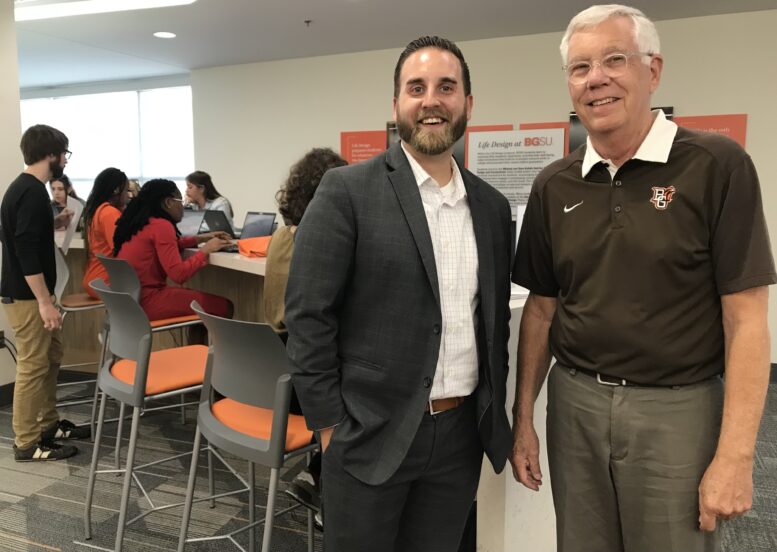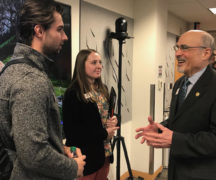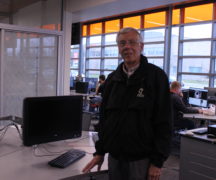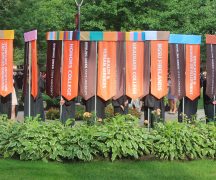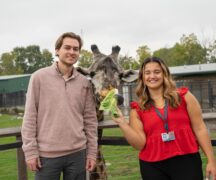By DAVID DUPONT
BG Independent News
Mike Kuhlin spent last week driving a golf cart to shuttle new students and their families from parking lots to residence halls.
The 1968 BGSU graduate took the time to chat with these new Falcons, asking them what they planned to study.
Some of them didn’t know. They were still trying to figure it out.
“Well, Life Design is for you, buddy,” Kuhlin said he told them.
This is the first academic year, in which all incoming students will be enrolled in the program, first through BGSU 1910 course, and then through the two-level program that offers academic and career counseling and coaching.
Life Design aims to help students from the time they arrive on campus to start planning on what they will do after they graduate.
The program was launched in fall, 2020 with about 1,000 students enrolled. In spring 2022, the university announced it had received a “transformational” gift of $13.5 million to support. Kuhlin, past chair of BGSU Foundation Board of Directors, and national university trustee Geoffrey H. Radbill, also a 1968 graduate, were the leading donors.
[RELATED: BGSU Life Design initiative gets a $13.5 million boost]
The program has two parts. The Radbill Center for Life Design is located on the third floor of the Mitchell B. McLeod Hall(formerly Mathematical Sciences Building). Starting with BGSU 1910, the center directs students through their academic path.
[RELATED: BGSU dedicates Radbill Center for Life Design that seeks to redefine student success]
The Michael and Sara Kuhlin Hub for Career Design and Connections is located on the second floor of the Bowen-Thompson Student Union.
The center, named for Kuhlin and his late wife, connects students with internships, coops, and other opportunities to test out their aspirations.
The work of the two entities, said Steve Russell, the senior vice president and executive director for the Kuhlin Center, is intertwined.
If a student in the 1910 course indicates a career they’d like to explore, a Kuhlin Center career coach can help make an initial contact for them.
It may be talking to someone on campus in the field, a BGSU graduate in the field, or even an older student who has experience in the field. Maybe there’s a job on campus the student can take.
“If this experience still intrigues them, then what’s the next step?”
Life design is about taking action, he said.
“When you think about life design,” Russell said, “what’s unique about BGSU is the scale, being able to do it in a comprehensive fashion across campus, with students in all majors, all years.”
The Radbill Center programming helps students build a toolkit to navigate through the university. Then the Kuhlin Center helps them build on that through experiences.
“We’re developing confidence,” Russell said.
Kuhlin credits BGSU President Rodney Rogers with the initiative.
Student engagement was a top priority for the university, and this takes it to a new level, Kuhlin said.
Rogers envisioned it not just as a two-year program but one that matched students’ interests with employment opportunities.
Life Design directly addresses the need to retain students through graduation. It also sets BGSU apart from other institutions as the first to have a four-year comprehensive Life Design program.
The Board of Trustees was fully behind it, but what made it possible was the financial commitment of himself and Radbill.
Their endowments mean, Life Design is not going away.
While a student may have thought the best, they could do would be a couple summer internships, now a variety of career experiences are integrated into their education.
Sometimes that means, they discover that they don’t want to pursue the field they were initially interested in. And that’s one of the benefits of the program. Best to learn that earlier than later.
Sometimes, it may mean a complete course change, or sometimes just a course correction.
A student may realize they don’t want to be a Certified Public Accountant in a large practice, but they may want to work with a non-profit.
The Radbill Center helps them tease out why they are interested in a field, and the Kuhlin Center its them in a position to test it out.
The Kuhlin center has four career coaches who handle broad areas of interest.
One coach focuses on business. Another focuses on those careers with social impact, such as education. Yet another covers the STEM professions, from advanced manufacturing to health care. And the fourth deals with humanities and the arts. These coaches are embedded the colleges close by the students and faculty.
Kuhlin noted that this is “the first semester out of the chute.”
Russell said they will take what they learn and modify it as necessary.
Maybe some areas will need additional coaches, or coaches will be needed in more specific areas.
“There is opportunity for growth and expansion as needs dictate,” Kuhlin said. “This is a learning process.”
The career coaches are the inward facing part of the hub, Russell said.
Then there are the “outward” facing staff who work with companies.
Life Design is also beneficial to them.
“Retention of early career talent is really terrible across the board in every industry,” he said.
Students coming out of BGSU’s Life Design program will have already worked in positions and talked to people in those industries. They have many ways of learning about the field and testing their interest in them.
“They know what they’re getting themselves into. They’ve already played this game,” Russell said. So, they won’t quit after six months. “That’s a huge selling point.”
That experience also means that they will be able to contribute from day one on the job.
They also build resilience. “You want to hire people who when they run into an obstacle, they utilize critical thinking to do something about it instead of running to the boss,” Russell said.
The emphasis is not just on the high demand fields. Both Russell and Kuhlin see ample job opportunities for students in the traditional liberal arts.
“There are businesses that seek liberal arts majors because of the breadth of their thinking and their education,” Kuhlin said.
In the past, Russell said, students may have excelled in their course work, but then had a difficult time finding appropriate employment after graduation because they hadn’t considered what that job would look like. From day one, Life Design helps students envision life after graduation.
Companies also need to be educated. A hospital may come looking for nurses and other health care professionals, but they also have other needs in business, human resources, public relations, and graphic design.
The Hub also makes it easy for companies to interact with the university. Colleges with their various academic and administrative units can seem a puzzle to outsiders. The hub gives those companies a one-stop shop to access the universities resources.
“You can talk to someone in the Hub and they’re always your point of contact,” Russell said. “They take in all the information on your needs, and they go and track down all that information across campus, and they come back and send you one email and say, ‘here’s all the details you need.’ That’s pretty clean.”
Though the program is still in its infancy, one company has already reached out and asked if BGSU staff can teach about Life Design as part of the firm’s leadership training.
Kuhlin said in remarks delivered early this summer at the ribbon-cutting for the hub that he gets satisfaction that BGSU is leading the nation in rolling out a four-year comprehensive program. Other institutions have already expressed interest in emulating BGSU’s Life Design initiative.

